![]()
![]()
![]()
Use LEFT and RIGHT arrow keys to navigate between flashcards;
Use UP and DOWN arrow keys to flip the card;
H to show hint;
A reads text to speech;
26 Cards in this Set
- Front
- Back
|
Araceae
Inflorescence a giveaway: a spadix subtended by a spathe Hemiepiphyte Anthurium(shown): large marginal collecting vein reticulate netlike venation and reflexed (folds back) spathe Philodendron: NO marginal collecting vein, lateral veins parallel |
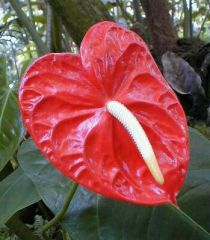
What is this plant?
|
|
|
Arecaceae {Palm) Family
Trees or Shrubs - NO branches Small tooth in center (hastula) |

What is the family?
|
|
|
Bromeliceae (Bromiliad Family)
Leaves simple alternate and spirally arranged Straplike and stiff Often a cuplike rosette Prickles at edge of leaf |
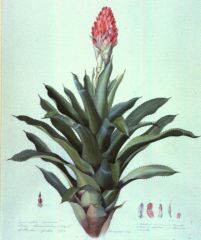
What is this family?
|
|
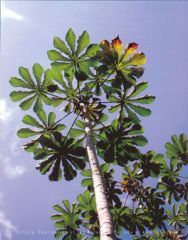
What is this family?
|

Cecropiaceae
Latex Palmately Lobed Leaves; peltate (Look at the picture) -- the leaves are actually all one lobed peltate leaf. |
|
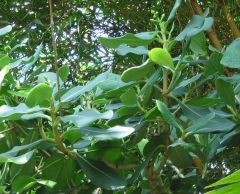
What is this family?
|

Clusiaceae
Leaves simple, oppopsite, entire (no serration, just normal margins) Terminal 2 leaves fused together, hiding apical meristem Often copious latex: yellow, orange, or white Clusia spp (shown): leaves fleshy, obovate with rounded apex. Latex white or yellow |
|
|
Costaceae (Spiral Gingers)
-Leaves spirally arranged -No stipules -Closed leaf sheaths |

What is this family?
|
|
|
Cyclanthaceae
-Leaves simple; alternate; most are bifid (2-cleft as in a hoof) -Stemless (or reallly reduced) -Can look like dwarf palms -Can be epiphytic Carludovica: terrestrial w/ 4-LOBED leaves w/o hastula Asplundia: terrestrial/epiphytic w/ bifid leaves - main genus Cyclanthus - terrestrial; unique in having thickened midrib in each bifid |

What is this family?
|
|
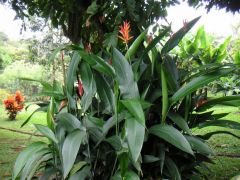
What is this family?
|

Heliconiaceae
-Asymmetrical Leaf Base -Leaves tear easily *The picture here is NOT heliconiaceae but is an example of what I mean by an "asymmetrical leaf base" |
|
|
Marantaceae (Prayer Plant)
- Like heliconiaceae but DOES NOT tear easily - S-shaped secondary veination -Pulvinis that changes turgor pressure -Pulvinus= discoloration, swelling at the base; torqued at petiole apex |
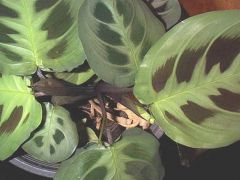
What is this family?
|
|
|
Melastomataceae
-Easiest to recognize because of characteristics leaf veintation: 1-4 pairs of veins arcuately parallel to the midvein; and crossveins perpendicular to the midvein -Simple, opposite leaves -Stamens modified (often have bent anthers) |
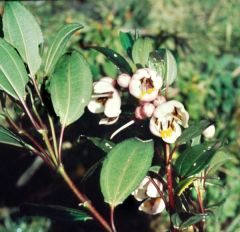
What is the family?
|
|
|
Moraceae
-Terminal Sheathing stipule that leaves circular scar marks all over twigs -Milky latex -Brachidodromous Ficus- Strangler fig -- most are hemi-epiphytic stranglers; leaves are 3-veined at base; latex copious; fruit a synconium |
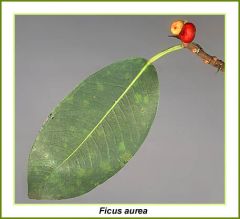
What is this family?
|
|
|
Orchidaceae
- 3-merous flowers with one petal modified into a lip or labellum -Stem often a pseudobulb -Mostly epiphytic |

What family is this?
|
|
|
Passifloraceae
-Mostly vines and liana, some trees and shrubs -Characteristic axillary tendril coming out at 45 degree angle -Easy to determine when in flower |

What family is this?
|
|
|
Piperaceae
-Strong peppery odor -Oblique base (asymmetrical) -Swollen, Jointed Nodes -Shrubs or herbs or epiphytes Piper: mostly shrubby, peppery odor, asymmetrical leaf bases and leaf-opposed densely spical infloresence Peperomia: A large genus; somewhat succulent, epiphytic herbs lacking odor Pothomorphie: Branched inflorescence and broad palmately veined leaves |
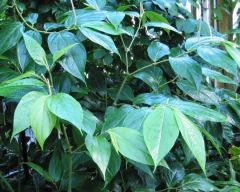
What family is this?
|
|
|
Rubiaceae - Coffee Family
-Leaves simple, opposite, entire -Interpetiolar stipules between leaves |
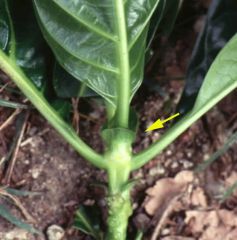
What is this family?
|
|
|
Rutaceae (Citrus)
-Easily recognizable by: 1) Pungent Citrus like aroma when crushed 2) Translucent dots on leaves -Herbs to Tree -Leathery leaves Citrus: Translucent dots, Aroma, Winged petioles, classic citrus fruit Zanthoxylurn: Odd-pinnately compound leaves and prickles on trunk. Sometimes prickles on leaves. Margins are generally serrate. |

What is this family?
|
|
|
Solanaceae Tomato/potato/eggplant family
- 5-merous - 5 stames that are sometimes closely appressed. - Odorus (tomato like or strong rank odor) |
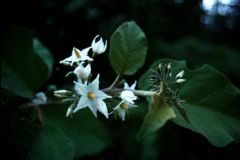
What is this family?
|
|
|
Zingiberaceae
-Usually strong sweet ginger-like odor - Large leaved monocots - 2-ranked leaves as in picture above - Usually glabrous (no hair) - Large elliptical leaves usually |
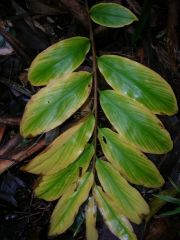
What family is this?
|
|
|
Apocynaceae (Dogbane/Milkweed) Family
- COPIOUS white Latex - Five-merous flowers - Simple, opposite leaves - Habit highly variable: herbs to trees, some vines and lianas too. |
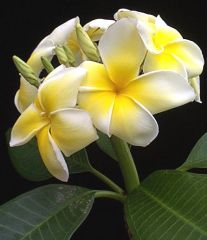
What is this family?
|
|
|
Describe the Boraginaceae family
|
-Mostly herbaceous but there are a few important woody tree and shrub genera in the tropics
-Leaves simple and alternate -Stiff pubescent leaves with entire margins -Distinctive dichotomous branching style of main tree genus (Cordia) |
|
|
What are the general characteristics of the fabaceae family?
What are the three subfamilies? |
-Mostly compound (usually (bi)pinnately)
-Leaflets entire/alternate -Petioles and petiolules with well-differentiated cylindrical swollen pulvini -The three subfamilies are: 1)Faboideae 2)Caesalpinioideae 3) Mimosoideae |
|
|
Describe the Faboideae subfamily
|
-Typical sweet-pea flower with 2 fused keel petals, 2 wings petals and 1 banner petal
-Leaves usually odd-pinate or trifoliate= 3 leaflets Describe the three genus!! 1) Erythrina: Distinctive genus w/ trifoliate leaves. Trunks sometimes with armature of prickles. 2) Gliricidia sepium: has fleshy rhombic leaflets with chemical-like odor and blue-green color 3)Dipteryx panamensis: Common, one-seeded fruit eaten by macaws and other critters |
|
|
Describe Caesalpinioideae
|
-Flower generally NOT pea-like; open w/ 2 keel petals, 2 wing petals and 1 banner petal which is INNERMOST unlike Faboideae
-Leaves are usually EVEN-pinnate Describe the THREE genera: 1) Bauhinia: Unique in bifid (or cleft) leaves resembling a cow's hoof. Some species are lianas while others are shrubs. 2) Caesalpinia:Spiny, yellow, showy flowers 3)Hymenaea: Weird tree with bifoliate leaves making it easy to pick out; bole smooth and grey 4)Parkinsonia: Shrubby tree species that is often spiny, with tiny almost vestigial leaflets and green photosynthetic rachis; growth form resembling a willow |
|
|
Mimosoideae
|
-Flowers distinctive with many long stamens
-Infloresence looks like a barber's shaving brush for putting on shaving cream (think old school) -Leaves generally bipinnately compound INGA Spp.= Once-pinnate leaves ,glands between the leaflet pairs and a rachis which is often winged. PENTACLETHRA MACROLOBA!!!!= Bipinnately compound leaves, lacking petiolar glands. |
|
|
Malvaceae
|
-Leaves simple alternate
-Plants usually have a mucilagenous sap -Palmately veined leaves -Sometimes palmately lobed leaves -Margins entire or toothed -Leaves usually palmately veined with STELLATE TRICHOME HAIRS -FLOWERS are DIAGNOSTIC: 5-merous with stamens fused into a TUBE -Stigmas emerge from center of tube and are usually swollen Genera! 1) Hibiscus: Shrubs with large flowers, serrate leaves and palmate venation 2)Malvaviscus: Similar to Hibiscus but has bright red flowers that are rolled into a tube 3) Sida: Common large and weedy genus found in disturbed habitats (esp. pastures, etc.). Leaves not palmately veined, serrate, yellow flowers |
|
|
Describe Tiliaceae
|
-Structurally similar to Malvaceae since they are now all Malvaceae
-Alternate leaves with stellate trichomes, almost always has serrate leaves, generally 3-veined at base Genera: 1) Luehea: Asymmetric serrate pentagonal shaped leaf w/ palmate venation. Underside of leaves tan brown. 2) Apeiba: Classic leaves with large fruit w/ armature of 'spines' |

